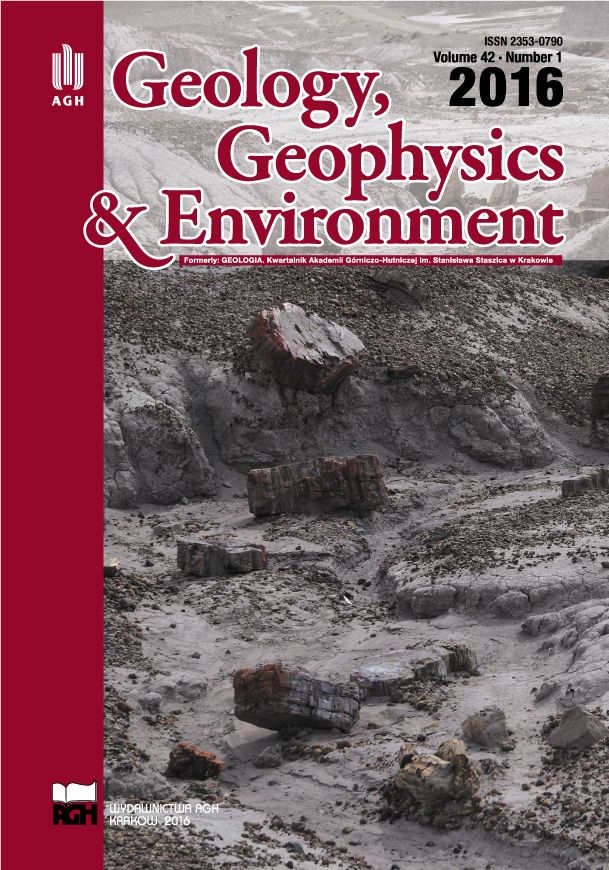Adsorption efficiency of selected natural and synthetic sorbents
DOI:
https://doi.org/10.7494/geol.2016.42.1.114Abstract
Sorbents are substances binding other substances on their surface. Effective sorbents have a porous surface. The adsorption activity of the surface is closely related to the local radius of curvature of surface irregularities. Suitable sorbents are natural and synthetic solids of amorphous or microcrystalline structure (Kyncl, Pavolová, Kyseľová, 2008). Globally, the following adsorbents are the most used: activated carbon, zeolites, silica gel, activated alumina (Bakalár et al., 2005). A characteristic of effective adsorbents is large surface area of hundreds of m2.g -1. Other important features of adsorbents include specific volume, porosity, average pore diameter, pore distribution, etc.
For sorption of heavy metal cations some natural materials or industrial waste with high sorption capacity, which naturally reduces the overall cost of their disposal, can be used. Some of low-cost sorbents are: lignin, chitin, seaweed / algae, zeolites, clays, fly-ash, peat, sand grains coated with iron oxide, modified cotton and wool (Pavolová, Bakalár, Kyseľová, 2006).
In experiments of Cu and Zn removal from wastewater the following adsorbents were used (Bakalár et al., 2005):
Lewatit S100 is strongly acidic, gel-like cationic ion exchange resin with particles of equal size based on styrene-divinylbenzene copolymers. Monodisperse beads are chemically and osmotically highly stable.
Chitosan is prepared from chitin, naturally occurring in the shells of crustaceans, by deacetylation using strongly alkaline solution. Chitin is a homopolymer composed of β-(1-4)-N-acetyl-D-glucosamine. The ability of crustaceans shells to bind metal ions is assigned to the presence of oxoskeleton in the molecule of chitin and chitosan.
Synthetic zeolite, which is the included in the group of aluminosilicates, was prepared by zeolitization of fly-ash from energy industry.
Bentonite is included in the group of hydrated aluminosilicates, the main ingredient is mineral montmorillonite.
Slovakia is an inorganic composite sorbent made from pure natural ingredients.
In removal of Cu2+, Zn2+ and Pb2+ cations the aspect of time, i.e. the time the specific sorbent reaches the maximum sorption capacity for the heavy metal removed, is also important. The experimental measurements of cations sorption using the above mentioned sorbents are made at the initial concentration of 10 mg.l-1 of heavy metal.
The time aspect of separation of Cu2+ cations from model solutions of wastewater reached relatively very good results because the time to reach the equilibrium for all sorbent was about 60 seconds except for chitosan for which it was almost 2 minutes.
The equilibrium of Zn2+ cations sorption was reached by about 80 seconds at the experimental measurements for all the selected sorbents except for chitosan for which this time was 2 minutes 5 seconds. This time was on average around 20 minutes longer compared to the sorption of Cu2+ ions.
The sorption of Pb2+ cations was carried out at the experimental measurements in about 83 seconds for all the selected sorbents, except for synthetic zeolite for which the time was 1 min 15 s. The sorption of Pb2+ cations compared to the cations of Cu2+ was 23 s faster and compared to the cations of Zn2+ was 3 s longer.
From the used sorbents the most appropriate for the removal of Cu2+, Zn2+, and Pb2+ is Lewatit S100, the equilibrium was reached in approximately 35 s, 45s, and 83 s for Zn2+, Cu2+, and Pb2+, respectively. According to the experimental measurements the longest adsorption time was for chitosan – about 2 minutes for Cu2+ and Zn2+, and about 1.5 minutes for Pb2+.
Downloads
References
Kyncl M., Pavolová, H. & Kyseľová, K., 2008. Using untraditional sorbents for sorption of certain heavy metals from waste water. GeoScience Engineering, 54, 2, 26-31.
Bakalár T., Búgel M., Schlosser Š. & Onderková B., 2005. Odstraňovanie ťažkých kovov z vodných roztokov. Acta Montanistica Slovaca 10, 1, 275-279.
Pavolová H., Bakalár T. & Kyseľová K., 2006. Efficiency of copper removal from wastewater using selected adsorbents. Acta Metallurgica Slovaca 12, 3, 275-281.
Downloads
Published
Issue
Section
License
Authors have full copyright and property rights to their work. Their copyrights to store the work, duplicate it in printing (as well as in the form of a digital CD recording), to make it available in the digital form, on the Internet and putting into circulation multiplied copies of the work worldwide are unlimited.
The content of the journal is freely available according to the Creative Commons License Attribution 4.0 International (CC BY 4.0)










